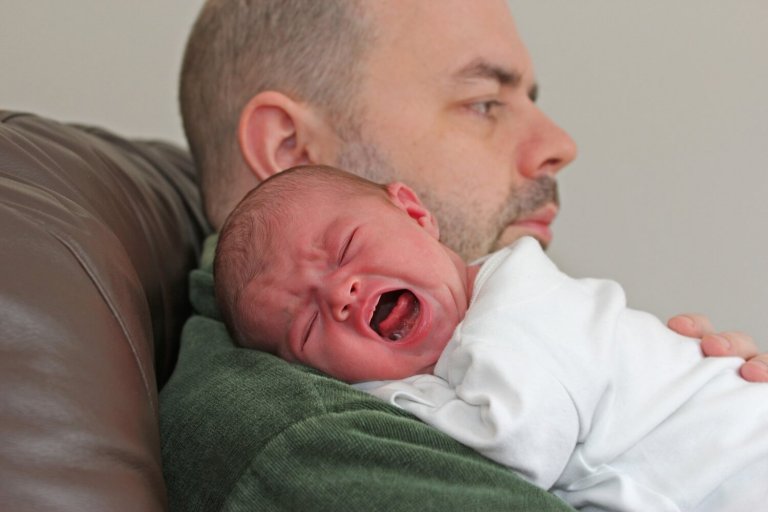How to Recognize When Your Child Is Suffering from Colic


Written and verified by the psychopedagogue María José Roldán
If your baby is suffering from colic, you can easily notice since they present very evident symptoms at this young age.
First of all, the baby starts to turn red, cry, close their fists, then their back arches and they raise their knees to their belly.
Colic is very common in infants. It usually starts two weeks after birth. In the case of premature babies it can occur a few weeks later.
It is a condition that can cause a well-nourished baby to cry for more than three hours straight, every day for more than three days a week, for more than three weeks.
Although colic isn’t harmful to their health, it can be very bothersome for the baby.
If your baby cries inconsolably and you’ve already previously confirmed that they’re healthy with their pediatrician, then your baby is likely suffering from this transient condition.
Colic hurts a lot and it usually disappears when the baby turns three or four months old. You shouldn’t be alarmed if your baby is suffering from colic, they’ll continue to eat and gain weight as they should.
To date, there is no scientific evidence that has shown that colic has long-term effects on a baby’s health.
The cause of this condition that leads to so many tears and pain is that the baby’s stomach is still very underdeveloped. They need time to get used to the food they receive outside the womb.
Like in adults, when babies suffer from colic, they’re filled with gas and this generates a lot of discomfort and pain.

Signs of colic
- Inconsolable crying episodes: a baby suffering from colic cries at the same time every day, usually during the evening or at night. Episodes of colic can last from only a few minutes to three hours or even more.
- Intense crying: The crying that is caused by colic sounds like a cry that is full of anguish. It is very intense. The crying usually has a high pitch, while crying the baby’s face can turn very red and it may be very difficult to soothe them.
- Their crying occurs for no apparent reason: it is normal for babies to cry. A crying baby may mean they need a diaper change, to be fed, or it could mean they’re too hot or too cold. If they cry for no reason, their tears are probably due to colic.
- Change in posture: A baby suffering from colic may have clenched fists, tense abdominal muscles and raised legs.

Parents should try to calm the baby with gentle massages on the belly accompanied by delicate leg movements. This will help relieve their cramping and expel gas. Patience is also important when confronted with their crying.
The cause of colic
Here are a few causes of colic that occur in babies who are a few days or months old:
- Reflux: Reflux is a condition in which the baby has heartburn due to the milk and stomach acid that flows into the esophagus.
- Digestive issues: digestive issues may be caused by protein or lactose intolerance.
- An immature digestive system can cause spasms of the intestinal muscles.
- Gas (air) in the intestinal tract.
- Higher hormone levels than usual: These hormones can cause restless moods and stomach pain.
- High sensitivity to stimulation from the environment such as light, sound, etc.
- Immature nervous system.
- High or low temperatures.
With the help of all of this information you’ll be able to easily recognize if your baby has colic. Knowledge will also allow you to act accordingly.
We’d like to remind you that you’ll need to give your baby all of the love in the world in order to allow them to feel safe and comfortable, which will in turn alleviate their discomfort.
As usual, your pediatrician will be able to provide all of the information you need to help your little one.
If your baby is suffering from colic, you can easily notice since they present very evident symptoms at this young age.
First of all, the baby starts to turn red, cry, close their fists, then their back arches and they raise their knees to their belly.
Colic is very common in infants. It usually starts two weeks after birth. In the case of premature babies it can occur a few weeks later.
It is a condition that can cause a well-nourished baby to cry for more than three hours straight, every day for more than three days a week, for more than three weeks.
Although colic isn’t harmful to their health, it can be very bothersome for the baby.
If your baby cries inconsolably and you’ve already previously confirmed that they’re healthy with their pediatrician, then your baby is likely suffering from this transient condition.
Colic hurts a lot and it usually disappears when the baby turns three or four months old. You shouldn’t be alarmed if your baby is suffering from colic, they’ll continue to eat and gain weight as they should.
To date, there is no scientific evidence that has shown that colic has long-term effects on a baby’s health.
The cause of this condition that leads to so many tears and pain is that the baby’s stomach is still very underdeveloped. They need time to get used to the food they receive outside the womb.
Like in adults, when babies suffer from colic, they’re filled with gas and this generates a lot of discomfort and pain.

Signs of colic
- Inconsolable crying episodes: a baby suffering from colic cries at the same time every day, usually during the evening or at night. Episodes of colic can last from only a few minutes to three hours or even more.
- Intense crying: The crying that is caused by colic sounds like a cry that is full of anguish. It is very intense. The crying usually has a high pitch, while crying the baby’s face can turn very red and it may be very difficult to soothe them.
- Their crying occurs for no apparent reason: it is normal for babies to cry. A crying baby may mean they need a diaper change, to be fed, or it could mean they’re too hot or too cold. If they cry for no reason, their tears are probably due to colic.
- Change in posture: A baby suffering from colic may have clenched fists, tense abdominal muscles and raised legs.

Parents should try to calm the baby with gentle massages on the belly accompanied by delicate leg movements. This will help relieve their cramping and expel gas. Patience is also important when confronted with their crying.
The cause of colic
Here are a few causes of colic that occur in babies who are a few days or months old:
- Reflux: Reflux is a condition in which the baby has heartburn due to the milk and stomach acid that flows into the esophagus.
- Digestive issues: digestive issues may be caused by protein or lactose intolerance.
- An immature digestive system can cause spasms of the intestinal muscles.
- Gas (air) in the intestinal tract.
- Higher hormone levels than usual: These hormones can cause restless moods and stomach pain.
- High sensitivity to stimulation from the environment such as light, sound, etc.
- Immature nervous system.
- High or low temperatures.
With the help of all of this information you’ll be able to easily recognize if your baby has colic. Knowledge will also allow you to act accordingly.
We’d like to remind you that you’ll need to give your baby all of the love in the world in order to allow them to feel safe and comfortable, which will in turn alleviate their discomfort.
As usual, your pediatrician will be able to provide all of the information you need to help your little one.
This text is provided for informational purposes only and does not replace consultation with a professional. If in doubt, consult your specialist.








